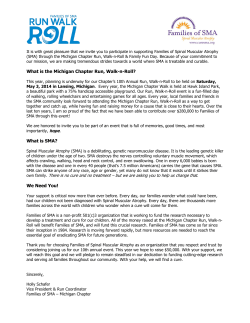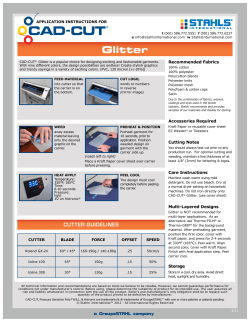
Detection of Spinal Muscular Atrophy Carriers in a Sample of the
Original Paper Neuroepidemiology 2011;36:105–108 DOI: 10.1159/000324156 Received: August 12, 2010 Accepted: January 3, 2011 Published online: February 18, 2011 Detection of Spinal Muscular Atrophy Carriers in a Sample of the Brazilian Population K.C. Bueno a S.P. Gouvea a A.B. Genari a C.A. Funayama a D.L. Zanette b W.A. Silva, Jr. b A.B. Oliveira d R.H. Scola c L.C. Werneck c W. Marques, Jr. a Departments of a Neurosciences and Behavior Sciences and b Genetics, School of Medicine of Ribeirão Preto, University of São Paulo, Ribeirão Preto, c Division of Neurology, Federal University of Paraná, Curitiba, and d Department of Neurology, Federal University of São Paulo, São Paulo, Brazil Key Words Spinal muscular atrophy ⴢ SMN1 gene ⴢ Denaturing high-performance liquid chromatography to other areas of the world where consanguineous marriage is not common. This should be considered in the process of genetic counseling and risk calculations. Copyright © 2011 S. Karger AG, Basel Abstract Background: Spinal muscular atrophy is a common autosomal recessive neuromuscular disorder caused by mutations in the SMN1 gene. Identification of spinal muscular atrophy carriers has important implications for individuals with a family history of the disorder and for genetic counseling. The aim of this study was to determine the frequency of carriers in a sample of the nonconsanguineous Brazilian population by denaturing high-performance liquid chromatography (DHPLC). Methods: To validate the method, we initially determined the relative quantification of DHPLC in 28 affected patients (DHPLC values: 0.00) and 65 parents (DHPLC values: 0.49–0.69). Following quantification, we studied 150 unrelated nonconsanguineous healthy individuals from the general population. Results: Four of the 150 healthy individuals tested (with no family history of a neuromuscular disorder) presented a DHPLC value in the range of heterozygous carriers (0.6–0.68). Conclusions: Based on these results, we estimated there is a carrier frequency of 2.7% in the nonconsanguineous Brazilian population, which is very similar © 2011 S. Karger AG, Basel 0251–5350/11/0362–0105$38.00/0 Fax +41 61 306 12 34 E-Mail karger@karger.ch www.karger.com Accessible online at: www.karger.com/ned Introduction Spinal muscular atrophy (SMA) is the 2nd most common lethal autosomal recessive disease. SMA affects approximately 1/6,000 to 1/10,000 live births [1–3] with a carrier frequency of 1/35 to 1/50 [3–6]. The disease is characterized by progressive muscle weakness and atrophy due to degeneration of motor neurons in the anterior horn of the spinal cord. The SMA-determining gene, called the survival motor neuron gene (SMN), is present on chromosome 5q13 and has two homologous copies: SMN1 and SMN2. More than 90% of SMA patients are associated with a homozygous deletion in the SMN1 gene [7–10]. The copy number of both SMN genes varies greatly in the population. The majority of affected individuals has no copies of SMN1; most carriers have 1 copy of SMN1, and noncarriers have 2–4 copies of the gene. Dr. Wilson Marques, Jr. University of São Paulo Av. Bandeirantes, 3900 Ribeirão Preto, SP 14040-900 (Brazil) Tel. +55 16 3602 3312, E-Mail wmjunior @ fmrp.usp.br SMA is considered to be a panethnic disorder, although most published studies to date involve small and heterogeneous sample sets of restricted populations [4, 5, 11–14]. If the carrier frequency in a population is high, the carrier test for SMA is an important part of the process of genetic counseling. The American College of Medical Genetics has recently recommended population carrier screening for SMA [15]. Reports of carrier frequencies in populations vary: there are low frequencies in African Americans (1/91) [14] and in the geographic regions of Spain (1/125) [14], Northeast England (1/80) [16], Warsaw (1/70) [17], South China (1/63) [18] and Israel (1/62) [19]; intermediate frequencies in Ashkenazi Jews (1/46), Caucasians (1/37) [14], Chinese (1/42) [20] and in the regions of Italy (1/57) [21], Asia (1/56) [14], Korea (1/47–1/50) [6, 22], North Dakota (1/41) [23], Philadelphia (1/40) [24], Poland and Germany (1/35) [3, 4], and France (1/34) [5]; and high frequencies in Saudi Arabia and Iran (1/20) [25, 26]. Considering the importance of SMA and the lack of population data in Brazil, this study was carried out to determine the carrier frequency of SMN1 deletions in a sample of the nonconsanguineous Brazilian population using denaturing high-performance liquid chromatography (DHPLC). Subjects and Methods Genomic DNA was isolated according to a standard protocol [27]. To amplify specifically the SMN1 gene in the polymerase chain reactions (PCR), the 3ⴕ ends of the primers were designed to finish on the SMN1-specific sequence in exon 7 at position 6 and intron 7 at position +2: the SMN1 forward primer is 5ⴕ-CCTTTTATTTTCCTTACAGGGTTTC-3ⴕ and the SMN1 reverse primer is 5ⴕ-GATTGTTTTACATTAACCTTTCAACTTTT-3ⴕ. As the reference gene, we used exon 12 of the human serum albumin (ALB). Its forward primer is 5ⴕ-AGCTATCCGTGGTCCTGAAC-3ⴕ, and the reverse primer is 5ⴕ-TTCTCAGAAAGTGTGCATATATCTG3ⴕ. Primer sequences were according to Lee et al. [6]. PCR were carried out in 50 l reaction volume containing 5 l dNTP (200 mM), 2 l of each SMN1 primer (10 pM), 2.5 l of each ALB primer (5 pM), 3 l MgCl2 (50 mM), 2.5 units Taq (Platinum쏐), 5 l 10! buffer (50 mM) and 2 l genomic DNA (100 ng), with the following cycling profile: 5 min denaturation at 95 ° C and 35 cycles of denaturation at 95 ° C for 30 s, annealing at 60 ° C for 30 s and extension at 72 ° C for 30 s, followed by 10 min of final extension step at 72 ° C. Reactions were carried out on a Gene Amp쏐 PCR System 9700 (Applied Biosystems). Amplicons were checked by 2% agarose gel electrophoresis before DHPLC analysis. For quantitative analysis, we initially determined the relative quantification of DHPLC in 28 affected patients and 65 parents with at least 1 child that possessed the homozygous deletion of exon 7. Following quantification, we studied 150 unrelated non 106 Neuroepidemiology 2011;36:105–108 Table 1. Copy number of the SMN1 gene in affected and carrier individuals Subjects SMN1 copy number RQ range Patients (n = 28) Parents (n = 65) 0 1 0.00–0.00 (0.00) 0.49–0.69 (0.60) Relative quantification (RQ) values calculated by WAVEMAKER software. Figures in parentheses show means. consanguineous healthy individuals from the general population, aged between 23 and 68, who had no family history of neuromuscular disorders. Informed consent for DNA analysis was obtained from each subject. This study was approved by the ethical committee of the University Hospital of the School of Medicine of Ribeirão Preto, University of São Paulo (Ethical Committee document HCMRP 3079/2004). All data were analyzed directly by DHPLC using the D.WAVE쏐 4.500 DNA-fragment analysis system (Transgenomic, San José, Calif., USA). We used ALB as a calibration sample. All tested samples were analyzed with the calibrator sample on every assay plate. Under nondenaturing conditions (50.8 ° C), the PCR products were eluted at 4.6 and 4.8 min, respectively. The elution profile of each amplicon is usually composed of 2 biphasic peaks. If no signal was detected for the PCR control (a sample without DNA), the data were analyzed. The results were expressed as the percentage of peak area for the SMN1 and ALB genes as calculated by WAVEMAKER software. The mean SMN1/ALB ratio derived from controls was used to normalize the percentage of peak area for the SMN1/ALB ratios of each individual. This calculation was performed according to the formula: (SMN1/ALB) test sample/(mean SMN1/ALB) controls. Results The percentage of peak area, which is proportional to the amount of PCR product in the reaction, was calculated automatically. In the linear phase of the PCR amplification, we expected SMN1/ALB gene ratios to be approximately 1.0 for normal controls, 0.5 for parents of SMA patients, and 0.0 for SMA patients with homozygous deletion of the SMN1 gene. The range of measured relative quantification in patients and carriers is shown in table 1. To estimate the frequency of carriers in the general population, we tested 150 nonconsanguineous healthy individuals, mostly from the southeast region of Brazil (table 2). To validate the analysis, we determined the range of carrier gene dosage in 28 affected patients (0.00–0.00) and 65 parents (0.49–0.69) of SMA patients in whom the homozygous deletion of the SMN1 gene was identified previBueno et al. Table 2. Results of the estimation of SMN1 copy number in 150 normal Brazilian individuals SMN1 copies RQ range Subjects 1 2 3 4 0.6–0.68 (0.66) 0.85–1.14 (0.97) 1.21–1.3 (1.25) 0.00–0.00 4 143 3 0 Total – 150 Frequency, % 2.7 95.3 2 0 100 Relative quantification (RQ) values calculated by WAVEMAKER software. Figures in parentheses show means. ously. Among the 150 healthy individuals tested, who had no known family history of genetic or neuromuscular disease, we detected 143 individuals who showed values compatible with 2 SMN1 gene copies (mean: 0.97; range: 0.85– 1.14). Three individuals also showed values compatible with 3 SMN1 gene copies (mean: 1.25; range: 1.21–1.3), and 4 individuals showed values compatible with 1 SMN1 gene copy (mean: 0.66; range: 0.6–0.68). Therefore, the screening of 150 nonconsanguineous healthy individuals predicts a carrier frequency for SMN1 deletion of approximately 1 in 37 Brazilians (2.7%). general population. Kim et al. [28] characterized the genotype of Brazilian patients with SMA, but they did not evaluate the carrier frequency of the deleted SMN1 gene in nonrelated and healthy Brazilians with no family history of SMA. To determine the carrier frequency in a sample of the Brazilian population using DHPLC, we initially determined the range of the carrier gene dosage in 65 parents of SMA patients (0.49–0.69). The homozygous deletion of the SMN1 gene in these patients had been previously identified by PCR restriction fragment length polymorphism and was confirmed in this study by DHPLC (table 1). Next, we screened 150 nonconsanguineous, healthy, normal individuals with no known family history of genetic or neuromuscular disease and found 4 individuals with a single SMN1 gene, resulting in a carrier frequency of 2.7% (1/37) for the tested population. This frequency is similar to populations in North Dakota (1/41) [23], Philadelphia (1/40) [24], Poland and Germany (1/35) [3, 4] and France (1/34) [5], and probably reflects the European origin of the population tested. This is the first report of SMA carrier frequency in a nonconsanguineous Brazilian population, and will help with genetic counseling for SMA. However, Brazil is a large country with many different ethnic origins, and the obtained data need to be confirmed in other regions of the country where the population may have different characteristics. Discussion Identification of the heterozygous carriers of the SMN1 deletion is important in genetic counseling for SMA, the second most lethal autosomal recessive disease [16]. In Brazil, to the best of our knowledge, there are no studies estimating the frequency of SMA carriers in the Acknowledgements The authors thank Sandra E. Marques and Renato Meirelles for skillful laboratory work. This work was funded by FAPESP, CNPq, CAPES and FAEPA. References 1 Pearn J: Classification of spinal muscular atrophies. Lancet 1980;i:919–922. 2 Czeizel A, Hamula J: A Hungarian study on Werdnig-Hoffmann disease. J Med Genet 1989;26:761–763. 3 Jedrzejowska M, Milewski M, Zimowski J, Jagozdzon P, Kostera-Pruszczyk A, Borkowska J, Sielska D, Jurek M, Hausmanowa-Petrusewicz I: Incidence of spinal muscular atrophy in Poland – more frequent than predicted? Neuroepidemiology 2010; 34: 152– 157. SMA Carriers in Brazil 4 Feldkotter M, Schwarzer V, Wirth R, Wienker TF, Wirth B: Quantitative analyses of SMN1 and SMN2 based on real-time lightCycler PCR: fast and highly reliable carrier testing and prediction of severity of spinal muscular atrophy. Am J Hum Genet 2002;70: 358–368. 5 Cusin V, Clermont O, Gérard B, Chantereau D, Elion J: Prevalence of SMN1 deletion and duplication in carrier and normal populations: implication for genetic counselling. J Med Genet 2003;40:e39. 6 Lee T, Kim S, Lee K, Jin HS, Koo SK, Jo I, Kang S, Jung S: Quantitative analysis of SMN1 gene and estimation of SMN1 deletion carrier frequency in Korean population based on real-time PCR. J Korean Med Sci 2004;19:870–873. 7 Lefebvre S, Burglen L, Reboullet S, Clermont O, Bulret P, Viollet L, Benichou B, Cruaud C, Millaseau P, Zeviani M, Paslier DL, Frezal J, Cohen D, Weissenbach J, Munnich A, Melki J: Identification and characterization of a spinal muscular atrophy-determining gene. Cell 1995;80:155–165. Neuroepidemiology 2011;36:105–108 107 8 Burglen L, Lefebvre S, Clermont O, Burlet P, Viollet L, Cruaud C, Munnich A, Melki J: Structure and organization of the human survival motor neuron (SMN) gene. Genomics 1996;32:479–482. 9 Wirth B: An update of the mutation spectrum of the survival motor neuron gene (SMN1) in autosomal recessive spinal muscular atrophy (SMA). Hum Mutat 2000; 15: 228–237. 10 Omrani O, Bonyadi M, Barzgar M: Molecular analysis of the SMN and NAIP genes in Iranian spinal muscular atrophy patients. Pediatr Int 2009;51:193–196. 11 Anhuf D, Eggermann T, Rudnik-Schöneborn S, Zerres K: Determination of SMN1 and SMN2 copy number using TaqMan technology. Hum Mutat 2003;22:74–78. 12 Ogino S, Leonard DG, Rennert H, Ewens WJ, Wilson RB: Genetic risk assessment in carrier testing for spinal muscular atrophy. Am J Med Genet 2002;110:301–307. 13 Ogino S, Wilson RB: Spinal muscular atrophy: molecular genetics and diagnostics. Expert Rev Mol Diagn 2004;4:15–29. 14 Hendrickson BC, Donohoe C, Akmaev VR, Sugarman EA, Labrousse P, Boguslavskiy L, Flynn K, Rohlfs EM, Walker A, Allitto B, Sears C, Scholl T: Differences in SMN1 allele frequencies among ethnic groups within North America. J Med Genet 2009; 46: 641– 644. 108 15 Prior TW: Carrier screening for spinal muscular atrophy. Genet Med 2008; 10:840–842. 16 Pearn JH: The gene frequency of acute Werdnig-Hofmann disease (SMA type I). A total population survey in Northeast England. J Med Genet 1973;10:260–265. 17 Spiegler AW, Hausmanowa-Pertrusewicz I, Borkowska J, Kłopocka A: Population data on acute infantile and chronic childhood spinal muscular atrophy in Warsaw. Hum Genet 1990;85:211–214. 18 Chan V, Yip B, Yam I, Au P, Lin CK, Wong V, Chan TK: Carrier incidence for spinal muscular atrophy in southern Chinese. J Neurol 2004;251:1089–1093. 19 Sukenik-Halevy R, Pesso R, Garbian N, Magal N, Shohat M: Large-scale population carrier screening for spinal muscular atrophy in Israel – effect of ethnicity on the false-negative rate. Genet Test Mol Biomarkers 2010;14: 319–324. 20 Sheng-Yuan Z, Xiong F, Chen YJ, Yan TZ, Zeng J, Li L, Zhang YN, Chen WQ, Bao XH, Zhang C, Xu XM: Molecular characterization of SMN copy number derived from carrier screening and from core families with SMA in a Chinese population. Eur J Hum Genet 2010;18:978–984. 21 Mostacciuolo ML, Danieli GA, Trevisan C, Müller E, Angelini C: Epidemiology of spinal muscular atrophies in a sample of the Italian population. Neuroepidemiology 1992;11:34– 38. 22 Yoon S, Lee CH, Lee KA: Determination of SMN1 and SMN2 copy numbers in a Korean population using multiplex ligation-dependent probe amplification. Korean J Lab Med 2010;30:93–96. Neuroepidemiology 2011;36:105–108 23 Burd L, Short SK, Martsolf JT, Nelson RA: Prevalence of type I spinal muscular atrophy in North Dakota. Am J Med Genet 1991; 41: 212–215. 24 Chen KL, Wang YL, Rennert H, Joshi I, Mills JK, Leonard DG, Wilson RB: Duplications and de novo deletions of the SMNt gene demonstrated by fluorescence-based carrier testing for spinal muscular atrophy. Am J Med Genet 1999;85:463–469. 25 Mohammed AJ, Ramanath M, Zahra R, Saad AR, Wafaa E: A pilot study of spinal muscular atrophy carrier screening in Saudi Arabia. J Pediatr Neurol 2007;3:221–224. 26 Hasanzad M, Azad M, Kahrizi K, Saffar BS, Nafisi S, Keyhanidoust Z, Azimian M, Refah AA, Also E, Urtizberea JA, Tizzano EF, Najmabadi H: Carrier frequency of SMA by quantitative analysis of the SMN1 deletion in the Iranian population. Eur J Neurol 2010;17: 160–162. 27 Miller SA, Dykes DD, Polesky HF: A simple salting out procedure for extracting DNA from human nucleated cells. Nucleic Acids Res 1988;3:1215. 28 Kim CA, Passos-Bueno MR, Marie SK, Cerqueira A, Conti U, Marques-Dias MJ, Gonzáles CH, Zatz M: Clinical and molecular analysis of spinal muscular atrophy in Brazilian patients. Genet Mol Biol 1999; 22: 487–492. Bueno et al.
© Copyright 2025










